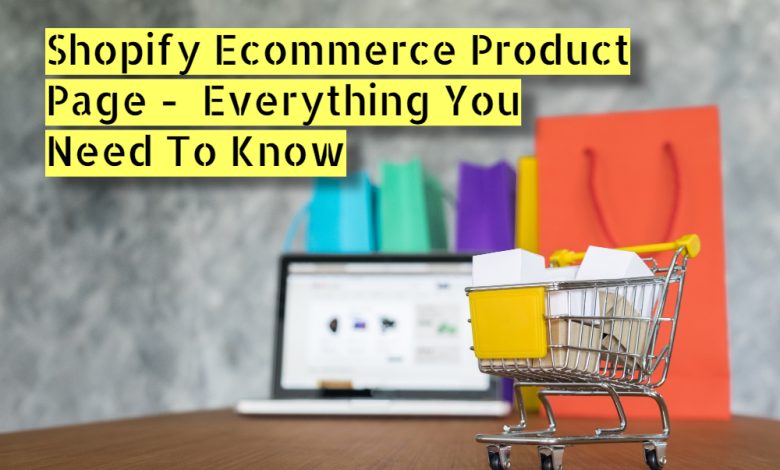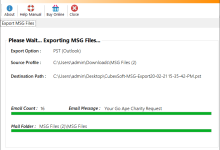Shopify Ecommerce Product Page – Everything You Need To Know

Did you know that ecommerce sales will total $4.28 trillion throughout the globe by the end of 2022? And this figure is expected to rise to $5.4 trillion by 2023. That’s a 26% gain!
For online product sales in Los Angeles, there’s never been a better moment to become persuasive than right now. Suppose you want your ecommerce business to succeed and develop. In that case, you ensure that every aspect of your website works correctly. And it all begins with a well-designed product page.
So, how do you develop a Shopify product page that converts? We’ll look at what makes a decent product page in this article. We’ll also cover the key features of an excellent website for a product, including how to hire a Shopify development agency to make your Shopify product pages your own and templates for your product pages that will help you get started quickly.
What is a Shopify product page?
Basically, a product page on your Shopify shop is where you include all the information about a particular item there.
It’s not only a list of data about the product on this page. It must convince customers to click the “Add to Cart” button on the product page. You might think of it as a landing page for your product’s marketing campaign.
Your product landing page, built with Shopify, has all the characteristics and features, pricing, guarantees, and incentives your visitors need to persuade them to begin the checkout process.
In the end, it may make or break a sale.
What’s the difference between landing pages and product pages?
A landing page might be a stand-alone for a particular marketing effort. Mostly, it focuses on a single goal: getting the user to complete a specific action with minimum distractions. Signing up for an email newsletter, taking an online course, or purchasing a product are examples of this behavior. Landing pages don’t need to be for an ecommerce product to have targeted offers.
A product page aims to persuade users to purchase a specific product by giving detailed information. Many of these sites don’t have a stated purpose of converting visitors into customers.
A landing page is often where you’ll just want one targeted link for visitors to click and may even eliminate navigation on the site. However, many of these pages feature multiple links that visitors may click to leave the page.
In e-commerce, landing pages and product pages are both valuable, but they are built for distinct reasons.
What can you sell with Shopify product pages?
Both physical and digital items benefit from having their own product pages. To make it simpler for users to discover your things by category, you may bundle these pages together through a collection page. Customization options for typefaces, picture size, zoom, and more are included on the standard Shopify product pages.
Shopify product page templates are a bit cookie-cutter in character and are commonly repurposed for expanding ecommerce businesses.
There isn’t a lot of space for a really personalized experience. To your great relief, Shopify applications from third parties may alter product pages. The originality and detail required for conversions will be ensured by this.
What does a good product page look like?
So, let’s look at the key elements you need to have on all of your Shopify product pages.
1. Product name
It should be clear to anybody who comes across your product page what you’re offering when they do so. That’s where things begin.
It’s best if your product’s name is
- Concise
- Descriptive
- SEO-friendly
Because “creative” product names may cause confusion for prospective customers—not to mention Google—it is preferable to stick with straightforward names. Because you want your product pages to be accessible for customers to locate through search engines and clear for them.
2. Enticing product images
Your product page’s conversion rate is directly related to the quality of your product photos. The Baymard Institute found that 56% of users began looking at product photographs as soon as they were on the page for a particular item. However, according to their study, just 25 percent of ecommerce sites could meet the expectations of their customers for product photographs.
The following are the two most important considerations:
Aspect ratio: Users’ dissatisfaction often extends to the website or brand rather than just the product itself. A product’s perceived quality and the brand’s perceived quality are influenced by low-quality photos. A professional photographer should be hired to take care of this. However, if you’re on a tight budget, you may always take your own pictures of the items. When photographing products, be aware of lighting conditions, choose the best product angles, and get close-up photos that may be interesting for buyers to see.
Zooming in and out: More than 93% of desktop e-commerce sites enable customers to zoom in on product photos. Sometimes, the zoom level on the photographs is inadequate to notice the visual information necessary to make a buying choice. Because of the lack of a deep visual grasp of critical product characteristics, some consumers leave the product page. For a closer look, make sure that the zoom-in option is enabled. Consider allowing customers to rotate the picture to view the product from various perspectives as an option. The lesson here is that if you want internet customers to purchase your goods, you need to let them see them first.
3. A detailed product description
In order to make an informed purchasing decision, prospective consumers should be provided with all the information they need in the product description. Ninety percent of the top 60 ecommerce sites today maintain high quality and consistency in their product page description.
If your brand doesn’t provide high-quality standards, your customers will notice and select a rival. This makes it the current standard in the market.
Sometimes, you may wish to offer additional information, like:
- In what form does it take?
- Exceptional characteristics
- There are several sizes to choose from (especially important for clothes or jewelry)
Your target audience will probably be interested in your unique selling features and highlights, so consider including them as well. Customers that care about the environment could be interested in learning that your product is manufactured from recycled materials. 78 percent of websites don’t employ ‘highlights’ to structure product page descriptions, boosting user engagement.
4. Quality product videos
Ecommerce shops may also use videos for uniquely advertising their items via their websites. 84 percent of respondents said they were persuaded to purchase a product or service after seeing a brand’s video.
The following are some examples of product videos from which you may select:
- Product tours
- Unboxing videos
- Production line videos
- How-to’s
Suppose you want to provide a product video with product photos. In that case, you should know that users struggle to discover product videos on as much as 35% of ecommerce websites.
Hire a Shopify developer Los Angeles to make your product videos easier to discover using these tips. Just add the video thumbnails and the picture gallery thumbnails to your page. Simple! Add a “play” symbol to your video assets and place them above your images in the gallery. Your Shopify shop may benefit significantly from adding video content to it.
5. Shipping information
Some of the most common reasons given for abandoning online shopping carts include:
- Additional charges, such as shipping and taxes (49 percent)
- The estimated delivery time is too long (19 percent)
- The inability to estimate the total cost of the transaction at the time of purchase (17 percent)
Customers don’t want to find out about shipping charges or delivery times until they’ve made a purchase. It’s better to present this information right up front on the product page, as it’s crucial. Free and quick delivery is the most important motivator for online purchases, according to a study by Walker Sands.
You may use this as an extra selling factor by showing free two-day delivery on your product page.
Conclusion:
The typical product pages of some of your rivals may be devoid of all the aspects that encourage customers to make a purchase. Besides increasing sales, these additional features may also provide your Shopify product pages a competitive advantage. Therefore, hire a Shopify development company to include videos, FAQ sections, and particularly strong review sections on your product pages.



